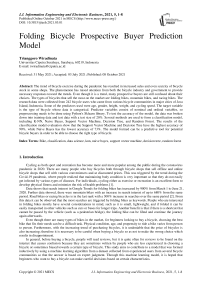Folding Bicycle Prospective Buyer Prediction Model
Автор: Trianggoro Wiradinata
Журнал: International Journal of Information Engineering and Electronic Business @ijieeb
Статья в выпуске: 5 vol.13, 2021 года.
Бесплатный доступ
The trend of bicycle exercise during the pandemic has resulted in increased sales and even scarcity of bicycle stock in some shops. The phenomenon has raised attention from both the bicycle industry and government to provide necessary responses toward the trends. Even though it is a trend, many prospective buyers are still confused about their choices. The types of bicycles that sell the most on the market are folding bikes, mountain bikes, and racing bikes. The research data were collected from 242 bicycle users who came from various bicycle communities in major cities of Java Island, Indonesia. Some of the predictors used were age, gender, height, weight, and cycling speed. The target variable is the type of bicycle whose data is categorical. Predictor variables consist of nominal and ordinal variables, so preprocessing needs to be done using Python's Sklearn library. To test the accuracy of the model, the data was broken down into training data and test data with a test size of 20%. Several methods are used to form a classification model, including K-NN, Naive Bayes, Support Vector Machine, Decision Tree, and Random Forest. The results of the classification model evaluation show that the Support Vector Machine and Decision Tree have the highest accuracy of 90%, while Naive Bayes has the lowest accuracy of 73%. The model formed can be a predictive tool for potential bicycle buyers in order to be able to choose the right type of bicycle.
Bike, classification, data science, knn, naive bayes, support vector machine, decision tree, random forest
Короткий адрес: https://sciup.org/15017794
IDR: 15017794 | DOI: 10.5815/ijieeb.2021.05.01
Список литературы Folding Bicycle Prospective Buyer Prediction Model
- P. J. W. Van Den Noort, “Promoting Cycling for Public Health,” L. Use Transp. Res., pp. 105–132, 2016.
- T. K. Yunianto, “Tren Gowes Kerek Penjualan Sepeda Hingga 30% Selama Pandemi,” Katadata, 2020. https://katadata.co.id/ekarina/berita/5f157dbd397ca/tren-gowes-kerek-penjualan-sepeda-hingga-30-selama-pandemi (accessed May 20, 2021).
- F. Pradolo, “Selama Pandemi Covid-19, Permintaan Sepeda Meroket 1.000 Persen,” Liputan 6, 2020. https://www.liputan6.com/bisnis/read/4384886/selama-pandemi-covid-19-permintaan-sepeda-meroket-1000-persen.
- A. B. Tamtomo, “INFOGRAFIK: Jenis-jenis Sepeda dan Tips Membeli Sepeda,” kompas.com, 2020. https://www.kompas.com/tren/read/2020/06/20/161659465/infografik-jenis-jenis-sepeda-dan-tips-membeli-sepeda (accessed May 20, 2021).
- H. Uden, S. Jones, and K. Grimmer, “Foot Pain and Cycling: a survey of frequency, type, location, associations, and amelioration of foot pain,” J. Sci. Cycl., vol. 1, no. 2, pp. 28–34, 2012, [Online]. Available: http://www.jsc-journal.com/ojs/index.php?journal=JSC&page=article&op =view &path[]=27%5Cnhttp://zadelpijn-expert.nl/data/ documents/Footpain-and-Cycling.pdf.
- W. Van Hoof, K. Volkaerts, K. O’Sullivan, B. Malfait, S. Verschueren, and W. Dankaerts, “Low Back Pain in Cycling: Does It Matter How You Sit?,” Br. J. Sports Med., vol. 48, no. 7, pp. 609.2-609, 2014, doi: 10.1136/bjsports-2014-093494.134.
- M. H. Zaki, T. Sayed, and X. Wang, “Computer vision approach for the classification of bike type,” J. Adv. Transp., vol. 50, no. 3, pp. 348–362, 2016, doi: http://dx.doi.org/10.1002/atr.1327.
- S. Jaya Prada, A. Geetha Sri, B. Venkateswarlu, C. Vineesha, and P. Lakshmi Teja, “Bike Buyer Prediction,” Int. J. Comput. Eng. Technol., vol. 11, no. 3, pp. 45–51, 2020.
- A. Singh, M. N., and R. Lakshmiganthan, “Impact of Different Data Types on Classifier Performance of Random Forest, Naïve Bayes, and K-Nearest Neighbors Algorithms,” Int. J. Adv. Comput. Sci. Appl., vol. 8, no. 12, pp. 1–11, 2017, doi: 10.14569/ijacsa.2017.081201.
- J. Dill and N. McNeil, “Four types of cyclists: Examining a typology to better understand bicycling behavior and potential,” Transp. Res. Board, vol. 500, pp. 1–18, 2013.
- B. Nazlı, G. Yasemin, and H. Altural, “Classification of Coronary Artery Disease Using Different Machine Learning Algorithms,” Int. J. Educ. Manag. Eng., vol. 10, no. 4, pp. 1–7, 2020, doi: 10.5815/ijeme.2020.04.01.
- N. Kesav and M. G. Jibukumar, “Complexity Reduced Bi-channel CNN for Image Classification,” Lect. Notes Networks Syst., vol. 141, pp. 119–131, 2021, doi: 10.1007/978-981-15-7106-0_12.
- D. Mukhopadhyay, A. Malusare, A. Nandanwar, and S. Sakshi, “An Approach to Mitigate the Risk of Customer Churn Using Machine Learning Algorithms,” Lect. Notes Networks Syst., vol. 141, pp. 133–142, 2021, doi: 10.1007/978-981-15-7106-0_13.
- B. Akinyemi, O. Adewusi, and A. Oyebade, “An Improved Classification Model for Fake News Detection in Social Media,” Int. J. Inf. Technol. Comput. Sci., vol. 12, no. 1, pp. 34–43, 2020, doi: 10.5815/ijitcs.2020.01.05.
- M. T. Sathe and A. C. Adamuthe, “Comparative study of supervised algorithms for prediction of students’ performance,” Int. J. Mod. Educ. Comput. Sci., vol. 13, no. 1, pp. 1–21, 2021, doi: 10.5815/ijmecs.2021.01.01.
- A. Adimabua Ojugo and E. Ekurume, “Predictive Intelligent Decision Support Model in Forecasting of the Diabetes Pandemic Using a Reinforcement Deep Learning Approach,” Int. J. Educ. Manag. Eng., vol. 11, no. 2, pp. 40–48, 2021, doi: 10.5815/ijeme.2021.02.05.
- D. Xhemali, C. J. Hinde, and R. G. Stone, “Naive Bayes vs. Decision Trees vs. Neural Networks in the Classification of Training Web Pages,” Int. J. Comput. Sci., vol. 4, no. 1, pp. 16–23, 2009, [Online]. Available: http://cogprints.org/6708/.
- D. K. Srivastava and L. Bhambhu, “Data classification using support vector machine,” J. Theor. Appl. Inf. Technol., vol. 12, no. 1, pp. 1–7, 2010.
- M. Thamarai and S. P. Malarvizhi, “House Price Prediction Modeling Using Machine Learning,” Int. J. Inf. Eng. Electron. Bus., vol. 12, no. 2, pp. 15–20, 2020, doi: 10.5815/ijieeb.2020.02.03.
- L. (University of C. B. Breiman, “Random Forests,” Stat. Dep., 2001, [Online]. Available: https://www.stat.berkeley.edu/~breiman/randomforest2001.pdf.
- A. Tharwat, “Classification assessment methods,” Appl. Comput. Informatics, vol. 17, no. 1, pp. 168–192, 2018, doi: 10.1016/j.aci.2018.08.003.
- F. Murtagh and K. Devlin, “The development of data science: implications for education, employment, research, and the data revolution for sustainable development,” Big Data Cogn. Comput., vol. 2, no. 2, pp. 1–16, 2018, doi: 10.3390/bdcc2020014.


